A tree tour to pine for. Fir real.
by joey |
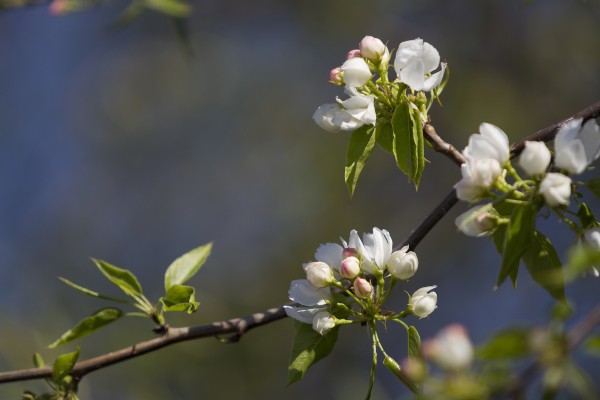
Spring has sprung and the pear blooms are blossoming. Celebrate the season with a UAA tree tour, including 79 diverse trees from around the world, including this Siberian pear. (Photo by Philip Hall / University of Alaska Anchorage)
Spring has (finally) sprung in Alaska and the evidence is everywhere-bike rentals on the corner, farmer's markets in the parking lots, giant tour buses plying the highways. On campus, though, spring arrives like it always does-as a vibrant green blanket of foliage enveloping the campus, home to the state's largest variety of tree species on public land.
Unlike most colleges, trees here tend to bloom after spring semester is already over. But once the trees wake up, the university transforms into a constantly changing urban forest, as each day brings more buds and blooms to beautify the campus.
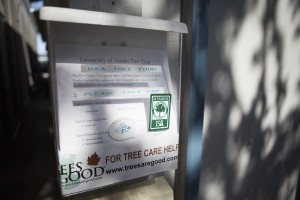
Tree tour guides are available all year long, at all hours of the day, on the landscaping office by Gordon Hartlieb Hall. (Photo by Philip Hall/University of Alaska Anchorage)
With trees from around the world, campus is like a curated botanical garden for the whole city. To appreciate the variety and global origins of the trees on campus, you can pick up a free guide from the UAA greenhouse. Although UAA's landscaping supervisor provides group tours upon request, the tree tour is available 24 hours a day as a self-guided circuit beginning at the campus greenhouse. Just pick up a guide from the plastic mailbox attached to the small shed by Gordon Hartlieb Hall and you'll be off on a botanical journey.
So take a tree tour! It's the perfect way to celebrate Alaska's upcoming Arbor Day on May 18. The Siberian pear blossoms are blooming and it's the most wonderful time of the year (aside from the color-changing pallet of fall, of course).
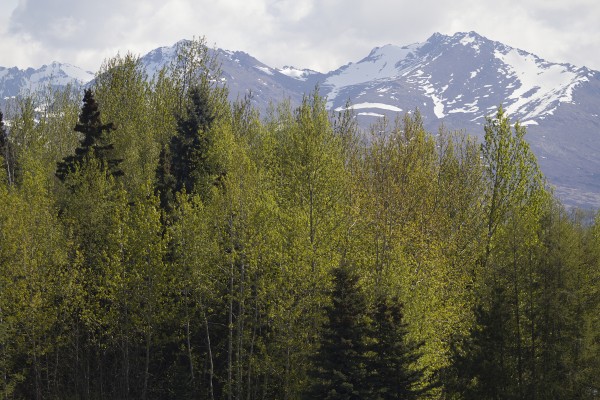
Snow on the mountain and green in the trees--it's springtime in Anchorage. (Photo by Philip Hall/University of Alaska Anchorage)
More trees, please
UAA loves its trees. In fact, the Arbor Day Foundation has honored UAA as a Tree Campus USA since the inaugural year of the program. To qualify, a campus must meet several criteria, including an annual Arbor Day observance (UAA's next event is May 29th, but more on that later).
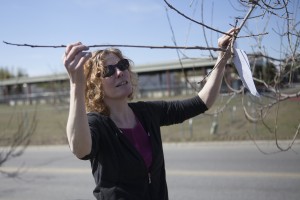
Catherine, a horticulturalist at UAA, displays the rapid one-year growth of tree #73, perhaps the only butternut tree in Anchorage. (Photo by Philip Hall/University of Alaska Anchorage)
"To put it simply, they want to make sure there are good stewards for the trees on campus and that things are planted correctly and taken care of," explained Catherine Shenk, a horticulturalist in UAA's landscaping department (and a walking guidebook of campus plants). Catherine leads UAA's tree committee-a mix of faculty, students, facilities staff and community members-and assists the university's ambitious "no net tree loss" program, replacing trees dug up during construction projects. Last year, UAA teams planted a thousand trees at Mat-Su College, a few thousand more at Kenai Peninsula College, and even 2,500 seedlings in three days on university land in Nikiski as the Funny River forest fire clouded the sky with smoke.
In the fall, Catherine gives several tree tours a week, primarily to third grade classes, who are learning about plant topics like photosynthesis back in the classroom. When they're on campus, though, it's a different story. "For the third graders, they're just having a blast being outside picking up leaves," Catherine smiled.
Catherine has made horticulture her career and, when she's providing a tree tour for the community, it's clear she's having a blast, too.
Tree treasure hunt
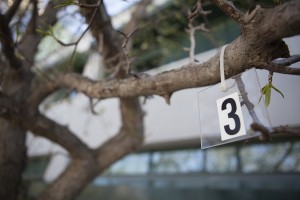
79 trees on campus are included on the tree tour, including #3, the Siberian pear (Photo by Philip Hall / University of Alaska Anchorage).
Part of the tour's fun is just finding the trees-with 79 specimens on the list, it's like a campus-wide scavenger hunt. Each tree is tagged with a plastic clip and a bold black-and-white number plate circling its branches. The numbers are hard to spot at first glance, but once you see the tags, you'll wonder how you didn't notice them before.
There's #7 on the list, an apple tree outside Rasmuson Hall that's a popular snack source for both moose and bold students.
There's Alaska's state tree-#44, the Sitka spruce-outside the Professional Studies Building. And just next door you'll find the aptly named limber pine-#45-with its wacky bendable branches.
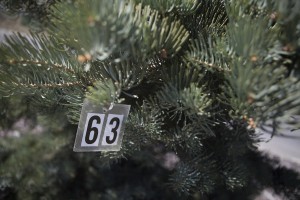
#63, the Pacific crabapple, is a rare native specimen amid the international trees behind the Auto Diesel Building (Photo by Philip Hall / University of Alaska Anchorage).
There's #17, the sweet-smelling alpine fir (agreeably outfitted in Christmas lights at the moment) and #5, the bristlecone pine, the oldest species of anything on earth (UAA's bristlecone is just a baby, but others have been growing for 5,000 years).
The tree tour listing is pretty barebones-just numbers, names and the date each tree was planted-though anyone armed with a smartphone can look up extra info.
For the full experience, you'll want to join the grounds crew for insider info. Like, for example, the background on tree #4-a Franken-plant outside Rasmuson Hall, built from borrowed parts. This tree combines the hearty Northern roots of the mountain ash with the fruit-bearing branches of the chokecherry. The abrupt bottleneck trunk evidences the fact that these two trees were grafted together. Fruit tree experiments are pretty common in Alaska, though, as local arborists continue to look for the best combination of tree and rootstock to produce fruit in Alaska.
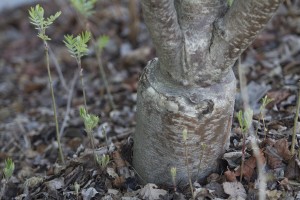
The trunk of tree #4--a mountain ash/chokecherry hybrid--shows the common practice of grafting trees together in Alaska. (Photo by Philip Hall/University of Alaska Anchorage)
The topic of growing fruit trees in Alaska is also the theme of UAA's Arbor Day event. Stop by UAA on May 29 for a presentation on tips and techniques for growing fruit trees this far North. After the presentation, Catherine will demonstrate what to look for when selecting a tree, where and how to plant, and continued care. Student volunteers from the audience will then plant three new fruit trees behind the Allied Health Sciences building. This latest addition will push the tree tour listings to 82. Like the trees themselves, the tree tour just keeps on growing.
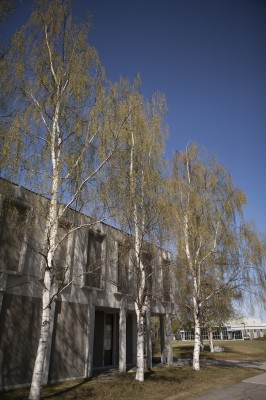
A wall of weeping birches (tree #24) fronts the east end of Eugene Short Hall. (Photo by Philip Hall/University of Alaska Anchorage)
And things keep changing as well. Spring happens quickly in Anchorage, and the trees get fuller and greener by the day. Soon enough, the chirping songbirds and squawking seagulls will be replaced by flocks of third graders on their fall field trips. Soon enough, the verdant shades of green on the trees will shift into rusty reds and oranges.
But for now, it's the leading edge of summer and its time to enjoy the return of the color green. Pick up a tree tour guidebook from the grounds office shed by Gordon Hartlieb Hall, mark your calendars for UAA's Arbor Day celebration and enjoy the carefully crafted beauty of our Tree Campus USA.
Celebrate Arbor Day with a presentation on planting fruit trees in Alaska. The presentation starts on May 29 at 12 p.m. in Rasmuson Hall Room 111, followed by the planting of three new fruit trees by the Allied Health Sciences building.
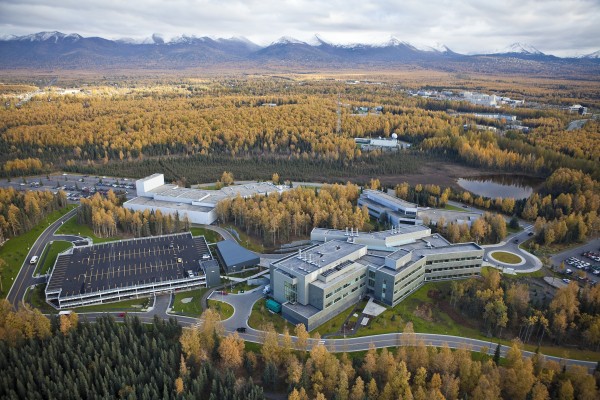
An overhead shot of campus in fall proves one thing about our Tree Campus USA-campus is completely blanketed by the surrounding forest of foliage. (Photo by Chris Arend)
 "A tree tour to pine for. Fir real." is licensed under a Creative Commons Attribution-NonCommercial 4.0 International License.
"A tree tour to pine for. Fir real." is licensed under a Creative Commons Attribution-NonCommercial 4.0 International License.














